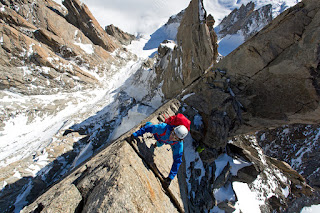My knowledge of the fashion world is minimal. In the 90s I subscribed to Vogue magazine, drawn to the unique clothing worn by people I did not know going to places that I’d never been. I saw the artistry. During this decade, Alexander McQueen was shaking up the fashion world with his extraordinary and shocking vision, a vision tinged with violence, suffering and survival above all. McQueen, then, was in my peripheral vision but I knew little about him.
In the documentary McQueen I learned much more. Lee Alexander McQueen was a brilliant, inspired and tortured visionary, who briefly made his mark, then was gone. After watching this story of his life, I learned I knew more about him than I suspected. He collaborated with artists who I do follow, like filmmaker Tim Burton and musicians David Bowie and Lady Gaga. His extraordinary vision shines through them.
This film, written by Peter Ettedgui and co-directed by Ian Bonhôte and Ettedgui, is beautifully produced with a home movie feel. It opens up this world to viewers who are fans, curious or perhaps are unaware of this rebellious designer. The film consists of intimate interviews with family members, close friends and colleagues along with footage from his fashion shows. There are also home videos, current and archived photos and a perfect music backdrop composed by McQueen’s collaborator, musician Michael Nyman.
Bonhôte and Ettedgui capture the lack of civility, the genius and McQueen’s ability to turn haunting nightmares into disturbing but memorable runway shows. The film explores the inspiration for and creation of five spectacular shows: “Jack the Ripper Stalks His Victims,” “Highland Rape” (probably his most controversial), “Search for the Golden Fleece,” “Voss” (his first show when he was brought onboard by Givenchy), and “Plato’s Atlantis.”
While much of the clothing appears unwearable and is shocking, nevertheless one can’t take one’s eyes off these theatrical and disturbing images. McQueen vehemently denied misogyny, saying “A man takes. The woman doesn’t give.” McQueen posited that his goal always was to make women look stronger. He clashed with the mainstream fashion industry and its focus on women as simply decorative. He wanted women to express strength and individuality in his runway events.
McQueen, the son of a taxi driver, burst of out of the East End of London, made a controversial and memorable name for himself, then took his own life at age 40 after achieving great success and notoriety. McQueen developed a love for fashion at an early age. In school, instead of listening to his teachers, he would doodle, drawing various items of clothing. He apprenticed for a small tailor on Savile Row as a pattern cutter at his mother’s suggestion, who took him on despite his skinhead appearance.
Not only did he cut - he was passionate about design and detail-oriented to a fault. Quickly, McQueen’s skills blossomed, and with no real knowledge of the fashion world, he applied to the prestigious Center St. Martin’s (whose alumni include Stella McCartney and John Galliano) and was accepted. From the beginning, his goal was to make people feel emotions, and as he said, he preferred they feel “repulsed or exhilarated.”
 |
| Photographer: Ann Ray Courtesy of Bleecker Street |
McQueen’s first collection was presented in 1992 - “Jack the Ripper Stalks His Victims.” It was the final project for the St. Martin’s Master’s program. Outrageous, energetic, passionate and deeply disturbing, the show featured Victorian-influenced pieces, black, pink and blood red, some tattered, others with human hair sewn in. Fashion trailblazer Isabella Blow attended that show and was stunned. She bought the entire collection and became a mentor to Alexander (Lee, to his friends) until he turned his back on her in later years. The naught persona remained with McQueen his entire life. He was admired, revered and hated, winning British Designer of the Year” twice in early years all the while courting a lot of negative press for his disturbing imagery.
Bonhôte and Ettedgui were thrilled they were able to gain access to McQueen’s sister and nephew, his colleagues Mira Chai Hyde (stylist) and Sebastian Pons (assistant designer), and early supporters in the fashion industry along with Issy Blow’s widower. It was important to the filmmakers that they not just include fashion editors and supermodels. They were striving for an authentic portrait of McQueen, the man. Perspectives of family, boyfriends and those with whom he collaborated made the film a very personal one rather than a career retrospective. Rare video and audio tapes and photos from McQueen’s early days of creation give the film the home movie sensibility.
Says Bonhôte, “We wanted to speak with all of the people in his life who were intimately connected with his creativity. He really was a kind of genius and extraordinary to watch. That’s what we wanted to capture. A bolt of cloth, a piece of chalk and an unerring ability to assess measurements produced trousers or a jacket almost instantly. He was a little like Mozart in Amadeus, an obsessive genius running on raw energy and instinct. There was something not quite civilized about him.”
 |
| Photographer: Ann Ray Courtesy of Bleecker Street |
As McQueen’s life moved toward an early end, he adopted the persona of the brand, something in his earlier years he vehemently opposed. Filled with doubt, he reflected, “I have to question my motives.” Despite his financial success, McQueen was still haunted; the exorcising of his demons through his designs and runway shows was not enough. McQueen was no longer the brash and happy young designer, but a darker, thinner man sporting high end men’s fashion, unsmiling. Losing Issy without reconciling with her, devastated him. Losing his mother was the final straw.
McQueen celebrates his life, his genius and his artistry in a personal and meaningful film and should not be missed. This trailer gives you a glimpse at the film. https://youtu.be/4OjX3ZbsfbU
McQueen opens Friday, August 17, in Albuquerque at UA High Ridge Theatre 8.













